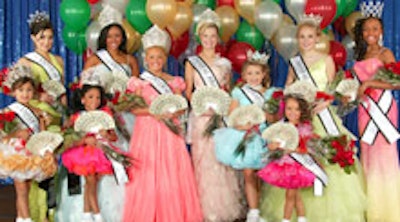
Contestants at a Universal Royalty pageant
Photo: Courtesy of Universal Royalty Beauty Pagent
It’s not all glitter and gold lamé for the pros who coordinate beauty pageants. While the contestants have their hearts set on a sash or a tiara, these multitasking planners are juggling anxious competitors (and parents), bus time lines, and sometimes even buckets, if a gown-drenching downpour threatens to wreck the big day.
Don’t get lost in translation. “You’re dealing with girls from all over the world, and there are cultural and language barriers,” says Lark-Marie Anton, director of marketing and PR for the New York-based Miss Universe Organization. “For instance, if you’re trying to explain to someone from a Latin culture that they have to be on the bus by 6 o’clock, 6 might mean 6:30 to them. It might mean come at your leisure.”
Be willing to tweak convention. “The girls were so eager to be shown in a different light,” says Dave Brunetti, executive producer of Miss New York, a franchise of the Miss America organization. “This year, I added a sequence where they had to wear work clothes, weekend wear, or other everyday garb. It was terrific watching them step out of the conception they had of themselves as pageant girls. They wound up in jeans, blouses, real clothes. One gal came in a hooded sweatshirt and workout pants, and it made such an impact because it perfectly represented her personality.”Focus on the big picture. “I get too involved in the details,” says Don Spradlin, executive producer of the San Francisco-based International Mr. Gay Competition. “What I have to do is take breaks and stay in overview/visualization mode and not get trapped in specifics. If I get too involved, I get taken away from the overall view, and then there’s no leader.”
Budget for time as well as costs. “We build some wiggle room into our payment deadlines, because we run into the problem of people not sending in fees in a timely manner,” says Annette Hill, owner of Universal Royalty, an Austin, Texas-based company that runs beauty competitions for children and teens. “The deposits pay for the pageant, and we have to make sure everything is paid for ahead of time, so we make the deadline earlier than we actually need it in anticipation of late payers.”
Harness the enthusiasm of participants. “I think it was really important for us to reconceptualize the way we were giving our awards out, so we don’t waste the talents of nonwinning contestants,” Spradlin says. “The thing that seems to motivate the contestants is if they can go home with a title, so we’re altering the judging process to recognize more talents and give out more titles. Our contestants can become valuable spokesmen, and we’ve got to use that talent. For instance, we have a couple of guys who were in the contest who wanted to be volunteers even after they didn’t win, to help us produce future events.”
Have a crisis plan in place. “We hold the pageant at an outdoor location, so we have learned to always have a backup location,” says Nancy Fletcher, model search manager assistant for the Miss Hawaiian Tropic pageant, held every year in the Aloha State. “We have a dressing room nearby large enough for all 76 contestants to wait out the weather. This past year, we had to rush the girls off the stage when it rained, while our staff came out with towels and mops to dry off the stage, because we didn’t want them to slip in their heels on a wet floor. It added an hour and a half to the pageant time.”
Let dissatisfied participants vent—on your time line. “You have 100 contestants and only 20 winners, so parents will often come up to me right after the event and want to know why their child didn’t win,” Hill says. “Before the pageant, I make a speech and tell them not to come to me right afterward, because I won’t have the judges’ reports yet. I tell them to wait a week before contacting me.”
Concentrate on the presentation. “Every pageant has a theme, and it is interesting to incorporate that into our decor and paperwork,” Fletcher says. “At our last U.S. pageant, our theme was ‘Island Radiance.’ We held it on the north shore of Oahu and had decor that symbolized the setting. We had a background of yellow and orange against a silhouette of Diamond Head, with an image of a girl in a hula skirt. We coordinated the judges’ welcome packets to that theme, and the girls wore black and gold evening gowns.”
Proofread everything one more time. “An extra eye sometimes spots things that may have been missed,” Fletcher says. “There are four people in this office, and on Tuesdays we all sit down and go over everything. Once, we had the incorrect date of our next pageant, but someone noticed it and we were able to correct it. That was a near miss.”
Don’t get lost in translation. “You’re dealing with girls from all over the world, and there are cultural and language barriers,” says Lark-Marie Anton, director of marketing and PR for the New York-based Miss Universe Organization. “For instance, if you’re trying to explain to someone from a Latin culture that they have to be on the bus by 6 o’clock, 6 might mean 6:30 to them. It might mean come at your leisure.”
Be willing to tweak convention. “The girls were so eager to be shown in a different light,” says Dave Brunetti, executive producer of Miss New York, a franchise of the Miss America organization. “This year, I added a sequence where they had to wear work clothes, weekend wear, or other everyday garb. It was terrific watching them step out of the conception they had of themselves as pageant girls. They wound up in jeans, blouses, real clothes. One gal came in a hooded sweatshirt and workout pants, and it made such an impact because it perfectly represented her personality.”Focus on the big picture. “I get too involved in the details,” says Don Spradlin, executive producer of the San Francisco-based International Mr. Gay Competition. “What I have to do is take breaks and stay in overview/visualization mode and not get trapped in specifics. If I get too involved, I get taken away from the overall view, and then there’s no leader.”
Budget for time as well as costs. “We build some wiggle room into our payment deadlines, because we run into the problem of people not sending in fees in a timely manner,” says Annette Hill, owner of Universal Royalty, an Austin, Texas-based company that runs beauty competitions for children and teens. “The deposits pay for the pageant, and we have to make sure everything is paid for ahead of time, so we make the deadline earlier than we actually need it in anticipation of late payers.”
Harness the enthusiasm of participants. “I think it was really important for us to reconceptualize the way we were giving our awards out, so we don’t waste the talents of nonwinning contestants,” Spradlin says. “The thing that seems to motivate the contestants is if they can go home with a title, so we’re altering the judging process to recognize more talents and give out more titles. Our contestants can become valuable spokesmen, and we’ve got to use that talent. For instance, we have a couple of guys who were in the contest who wanted to be volunteers even after they didn’t win, to help us produce future events.”
Have a crisis plan in place. “We hold the pageant at an outdoor location, so we have learned to always have a backup location,” says Nancy Fletcher, model search manager assistant for the Miss Hawaiian Tropic pageant, held every year in the Aloha State. “We have a dressing room nearby large enough for all 76 contestants to wait out the weather. This past year, we had to rush the girls off the stage when it rained, while our staff came out with towels and mops to dry off the stage, because we didn’t want them to slip in their heels on a wet floor. It added an hour and a half to the pageant time.”
Let dissatisfied participants vent—on your time line. “You have 100 contestants and only 20 winners, so parents will often come up to me right after the event and want to know why their child didn’t win,” Hill says. “Before the pageant, I make a speech and tell them not to come to me right afterward, because I won’t have the judges’ reports yet. I tell them to wait a week before contacting me.”
Concentrate on the presentation. “Every pageant has a theme, and it is interesting to incorporate that into our decor and paperwork,” Fletcher says. “At our last U.S. pageant, our theme was ‘Island Radiance.’ We held it on the north shore of Oahu and had decor that symbolized the setting. We had a background of yellow and orange against a silhouette of Diamond Head, with an image of a girl in a hula skirt. We coordinated the judges’ welcome packets to that theme, and the girls wore black and gold evening gowns.”
Proofread everything one more time. “An extra eye sometimes spots things that may have been missed,” Fletcher says. “There are four people in this office, and on Tuesdays we all sit down and go over everything. Once, we had the incorrect date of our next pageant, but someone noticed it and we were able to correct it. That was a near miss.”



















